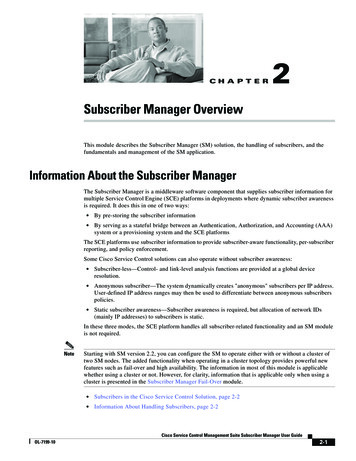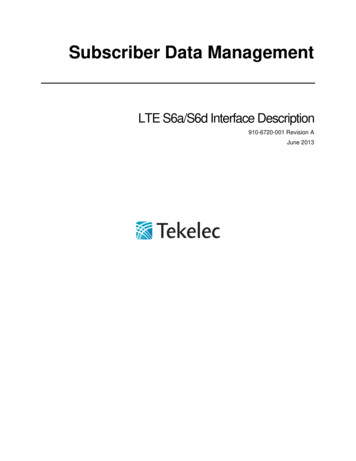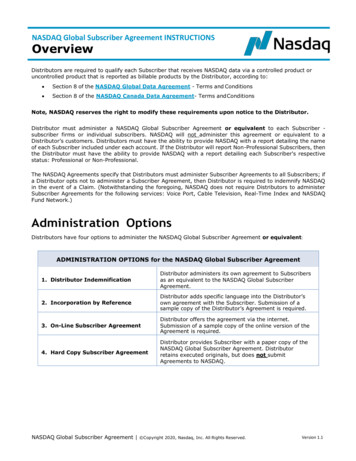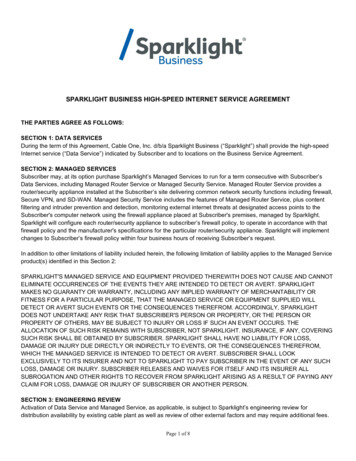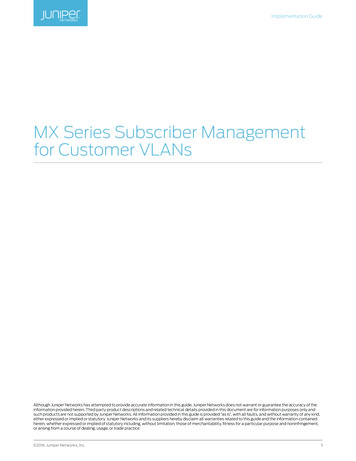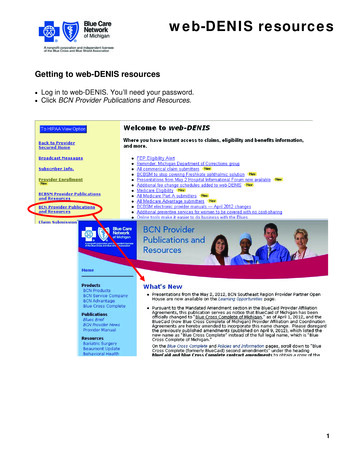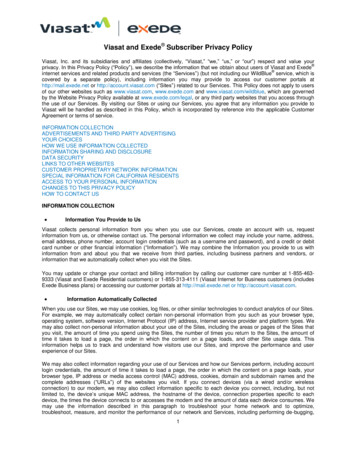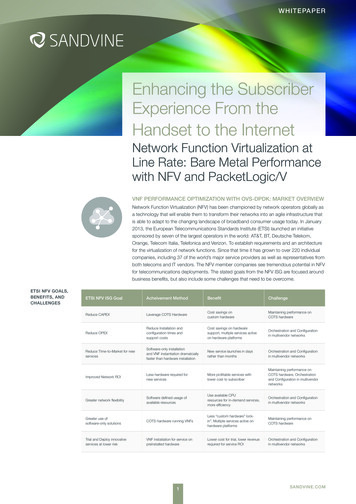
Transcription
WHITEPAPEREnhancing the SubscriberExperience From theHandset to the InternetNetwork Function Virtualization atLine Rate: Bare Metal Performancewith NFV and PacketLogic/VVNF PERFORMANCE OPTIMIZATION WITH OVS-DPDK: MARKET OVERVIEWNetwork Function Virtualization (NFV) has been championed by network operators globally asa technology that will enable them to transform their networks into an agile infrastructure thatis able to adapt to the changing landscape of broadband consumer usage today. In January2013, the European Telecommunications Standards Institute (ETSI) launched an initiativesponsored by seven of the largest operators in the world: AT&T, BT, Deutsche Telekom,Orange, Telecom Italia, Telefonica and Verizon. To establish requirements and an architecturefor the virtualization of network functions. Since that time it has grown to over 220 individualcompanies, including 37 of the world’s major service providers as well as representatives fromboth telecoms and IT vendors. The NFV member companies see tremendous potential in NFVfor telecommunications deployments. The stated goals from the NFV ISG are focused aroundbusiness benefits, but also include some challenges that need to be overcome.ETSI NFV GOALS,BENEFITS, ANDCHALLENGESETSI NFV ISG GoalAcheivement MethodBenefitChallengeReduce CAPEXLeverage COTS HardwareCost savings oncustom hardwareMaintaining performance onCOTS hardwareReduce OPEXReduce Installation andconfiguration times andsupport costsCost savings on hardwaresupport, multiple services activeon hardware platformsOrchestration and Configurationin multivendor networksReduce TIme-to-Market for newservicesSoftware-only installationand VNF instantiation dramatciallyfaster than hardware installationNew service launches in daysrather than monthsOrchestration and Configurationin multivendor networksImproved Network ROILess hardware required fornew servicesMore profitable services withlower cost to subscriberMaintaining performance onCOTS hardware, Orchestrationand Configuration in multivendornetworksGreater network flexibilitySoftware defined usage ofavailable resourcesUse available CPUresources for in-demand services,more efficiencyOrchestration and Configurationin multivendor networksGreater use ofsoftware-only solutionsCOTS hardware running VNFsLess “custom hardware” lockin”, Multiple services active onhardware platformsMaintaining performance onCOTS hardwareTrial and Deploy innovativeservices at lower riskVNF instatiation for service onpreinstalled hardwareLower cost for trial, lower revenuerequired for service ROIOrchestration and Configurationin multivendor networks1SANDVINE.COM
WHITEPAPERTransform yournetworks into anagile infrastructurethat is able to adaptto the changinglandscape ofbroadband consumerusage today.THE NFV PERFORMANCE DILEMMAAs shown above, performance is one of the major challenges facing NFV implementations.The performance challenge has proven to be significant in the migration from customhardware to Commercial Off the Shelf (COTS) hardware for some vendors. NFV has beentouted for it’s ability to reduce costs, but in order to achieve this, the performance gapbetween COTS and custom hardware must narrow from what was initally experienced byvendors implementing software-only implementations of their Virtual Network Functions (VNF).The NFV performance dilemma can be broken into two distinct camps: Control Plane andData Plane. Control Plane performance can be CPU intensive due to the transactionalnature of control plane functions, i.e. millions of small transactions coming to servers on thenetwork. Most control plane applications are implemented on COTS technology today, andthe challenge to virtualize those applications was straightforward. Data plane implentationshave traditionally relied on specific hardware configurations or hardware-assist for achievingperformance (whether through ASICs, FPGAs, network processors, or specialized processors)in order meeting network operator’s growing performance needs. The goal of NFV is toremove hardware dependencies, so data plane VNF implementations must optimize aroundthe lowest common denominator for a standard COTS hardware configuration. Data planeapplications also require predictable performance despite the CPU and I/O intensive natureof their implementations, and the shift to NFV does not remove that requirement. Networkoperators require predictable performance from data plane systems so that they candimension their networks to ensure a high quality of experience in delivering content andservices to their subscribers, especially during peak usage times.In the NFV architecture, the concept is for multiple VNFs to run on a COTS platform, asshown in the Figure 1.Figure 1HIGH LEVEL NFVARCHITECTUREVIRTUAL VNFV MANAGEMENT & ORCHESTRATIONNFV ORCHESTRATORINFRASTRUCTUREVIRTUAL orkVIRTUALMACHINESVIRTUALIZATION LAYER - HYPERVISORINFRASTRUCTUREORCHESTRATORPREElementsVNF MANAGERVIRTUAL INFRASTRUCTURE MANAGER(S)HARDWARE RESOURCESComputingStorageNetwork2SANDVINE.COM
WHITEPAPERCASE STUDYOvercoming theperformancechallenges requiresa close collaborationof all of the abovecomponents toachieve the costsavings that aredesired by thenetwork operators.The diagram above shows several connection points that are potential bottlenecks in meetingany performance goals for NFV. First, the COTS hardware should offer the maximum amountof performance available. The ability of the Virtual Switch to offer line rate performance to theVirtual Machines and the COTS hardware is a critical factor, and the Virtual Machine shouldconsume minimal resources in order not to take performance away from the VNF software.Although the concepts are simple, achieving maximum performance from NFV solutions hasproven to be more difficult than expected for many VNF suppliers. Most network operatorsare expecting anywhere from a 10-25% performance penalty when running NFV-basedsolutions versus hardware-based solutions, which often eliminates any potential cost savingsin hardware (although still leaving other benefits to the operator). Overcoming the performancechallenges requires a close collaboration of all of the above components to achieve the costsavings that are desired by the network operators.Meeting the performance requirements of network operators and VNF suppliers requiresan extremely stable reference platform that can easily be replicated at the software andvirtualization layer, regardless of hardware platform. Network operators need to ensure thatthe COTS hardware systems that they purchase can run the broadest range of VNF solutionswith high performance, and VNF providers need to optimize their software around a commonset of interfaces and platforms that they can rely on for their solutions. Although there aremultiple virtualization platforms available on the market, the critical consideration for dataplane applications is the data plane acceleration tools available in the virtualization platforms.Commercial options are offered from various companies that can offer higher performance tomany applications as add-ons to the base virtualization platforms for an additional cost. Thereare several non-commercial (i.e. bundled) options that are also being offered to solve thisproblem. Intel has opened up their Data Plane Development Kit (DPDK) and the Open VirtualSwitch software to enable performance on open systems.INTEL’S ACCELERATION STRATEGY AND SOLUTIONSIntel’s enablement work for SDN and NFV within this emerging model of network infrastructureis embodied in Intel Open Network Platform (ONP). The over-arching goal of Intel ONP is toreduce the cost and effort required for service providers, data-center operators, TEMs, andOEMs to adopt and deploy SDN and NFV architectures. The foundations of this effort are theIntel ONP Server Reference Design, introduced in the second half of 2014, and the Intel ONPSwitch Reference Design, introduced in 2013.Intel delivers a number of platform-level features and capabilities enhance the performance,reliability, and security of the Intel ONP for Servers reference design, which is architectedon Intel Xeon or Intel Core processor-based systems. The technologies describedin this section are open source and optimized to work on open standards and are thereforeapplicable to SDN and NFV implementations outside the scope of the reference design.INTEL DATA PLANE DEVELOPMENT KIT (INTEL DPDK) USE INOPEN VSWITCHThe set of software libraries comprising Intel DPDK can be used to dramatically acceleratepacket processing by software-based network components, for greater throughput andscalability. Engineering teams from Intel and Wind River collaborated to replace the dataplaneswitching logic of the open source Open vSwitch project with a new version built on top ofIntel DPDK to improve the small packet throughput. The resulting project, which is called theIntel DPDK Accelerated Open vSwitch, offers dramatic improvements to packetswitchingthroughput and is offered as a reference implementation for use with Intel ONP for Serversand other NFV solutions. The mainstream Open vSwitch project has also started to adoptDPDK connectivity as an optional configuration.3SANDVINE.COM
WHITEPAPERCASE STUDYFigure 2INTEL ONP ARCHITECTUREThe source code for the base Intel DPDK library as well as the Open vSwitch enhancementsthat take advantage of DPDK libraries are readily available for development organizations thatwish to extend the public projects or to pursue custom development on their own.INTEL QUICKASSIST TECHNOLOGYHardware-based acceleration services for workloads such as encryption and compressionare supported by Intel QuickAssist Technology, using an open-standards approach thatis well suited to use with Intel ONS for Servers and other SDN and NFV implementations.An accelerator abstraction layer provides a uniform means of communication betweenapplications and accelerators, as well as facilitating management of acceleration resourceswithin the control and orchestration layers of the Intel ONP architecture.INTEL VIRTUALIZATION TECHNOLOGY (INTEL VT)Capabilities at the virtualization layer itself also play a key role in the robustness of SDN andNFV implemented on Intel architecture. Enablement by Intel for all of the major virtualizationenvironments—including contributions to open-source projects and co-engineering withproviders of proprietary offerings—provides robust support for Intel VT. The hardware assistsfor virtualization offered by Intel VT dramatically reduce overhead, by eliminating the needfor software-based emulation of the hardware environment for each VM. As a result, IntelVT enables higher throughput and reduced latency. It also enhances data isolation betweenvirtual machines (VMs), for greater security.These technologies form a strong reference platform that VNF providers can develop on, andSandvine is leveraging this architecture fully.4SANDVINE.COM
WHITEPAPERCASE STUDYSANDVINE’S NFV STRATEGY AND SOLUTIONSSandvine’s strategy for NFV is to deliver software-based VNF solutions that meet theperformance expectations of network operators by matching the performance capabilitiesof our hardware-based solutions. Sandvine has always been a software company, and ourcustomers recognize that we deliver more performance per CPU cycle than anyone else in ourmarket. We have historically utilized COTS hardware in specific configurations to run our highperformance software solutions, and this leveraged our knowledge of how to tightly integratewith hardware to get maximum performance out of that hardware configuration.The current PacketLogic solutions run on a mixture of COTS appliances and servers, and themain software components will remain the same, as shown in Figure 3.Figure 3PACKETLOGIC/V ARCHITECTUREVisualize & ReportUE(ANDSFCLIENT)ANALYTICS ENGINEAlarms,Logs, StatsAl arms ,Logs , StatsAlarms,Logs, StatsOs-Ma-nfvo(REST)CDMOPENETVNF MANAGERS14ANDSFVNFSyOC SVNFP C edUser FlowsGxD RAVNFGxSP RVeNf-Vnfm-vnfSANDVINEVNF MANAGEROr-Vnfm(REST)AMARTUSNFV torageVirtualNetworkNF V ISubscriberAwareness& PoliciesV IMVIRTUALIZATION ardwareNf-ViThere is one major new component introduced into PacketLogic with PacketLogic/V, and thatis the VNF-Manager solution shown in the diagram, and that is designed to solve the secondmajor issue that we identified in the overview, but outside the scope of this performancewhitepaper. Outside of the VNF Manager, the goal is to deliver carrier-scale performanceacross all of our VNFs. The strategy for PacketLogic/V was to leverage the Intel toolkit aboveto deliver our solution as a pure software VNF offering, and match the performance that weachieve in our hardware-based offerings. Sandvine has worked to maximize our performanceon SandyBridge and IvyBridge on our existing Intel-based hardware solutions with Intel in thepast, and when we began our investigation into achieving high performance on NFV systems,we once again opened that channel.5SANDVINE.COM
WHITEPAPERCASE STUDY2014 PERFORMANCE: PACKETLOGIC/VWe initially began testing on a Virtual CPE solution with HP and Intel and were able to get 700Mbps per instance on a stock HP system running VMware, which maxed out the I/Ocapacity of the VMware virtual interfaces at the time, as our CPU utilization was only 12%.This was a good start for the low end of the market (sub-1Gbps), but not attractive for mostbroadband operators that have multiple 10Gbps links to the network. We began working withIntel and optimizing our interfaces to the NFV reference architecture, and eventually achievedthe performance numbers in the graph in October of 2014:As Figure 4 shows, with Intel Xeon Processor E5-2600 v3 Haswell CPUs we are achievingthe maximum performance possible with the I/O that can be placed in a standard COTSserver (4x10GE).Figure 4LEGEND:150THROUGHPUT ACHIEVED (GBPS)2014 PACKETLOGIC/VPERFORMANCEPHASE 1PHASE 2PRE COLLABORATIONPHASE 2.1PHASE 3POST COLLABORATION10050MAX I/O CAPACITY(20 GBPS)0.65.510.62040MAX I/O CAPACITY(80 GBPS)MAX I/O CAPACITY(40 GBPS)0INTEL XEON E5-2600SandyBri dgeINTEL XEON E5-2600v3HaswellThis is also roughly equivalent to the performance achieved in the COTS appliances thatSandvine delivers to our network operator customers today, which delivers on the strategy ofallowing the customer to choose their own platform with no performance penalty for NFV orhardware-based solutions.In this type of deployment, the limiting factor will be I/O ports, and not the CPU in the server.There are several server vendors that are tacking the I/O density challenge, and if thatsolution is solved, it will enable NFV to solve the dense 10GE network deployments that arecommonplace in the core network today. It also highlights the need for 100GE interfaces forservers, which the performance numbers that are being achieved on Haswell show can besupported with a VNF solution.As NFV and the data plane server market matures, NFV has unlimited potential to meet eventhe most demanding network performance required by network operators today. Usingblade server solutions, scalability into the hundreds of Gbps is easily achievable, and as100GE matures in the data center, network operators will be able to take advantage of thoseinterfaces in their deployments.6SANDVINE.COM
WHITEPAPERCASE STUDY2015 PERFORMANCE: PACKETLOGIC/VIn 2015, Sandvine continued to push the performance limits with the Intel Xeon ProcessorE5-2600 v3 Haswell CPUs by moving from 4x10GE ports to 4x40GE ports for the I/O on theserver. In this scenario, the system is now able to achieve up to 160Gbps of I/O performancerather than the 40Gbps that was tested in 2014. This is the same CPU configuration that issupported in the PacketLogic PL9420 system, and provides a good guideline for comparinga purpose-packaged appliance to an NFV equivalent COTS server. In this configuration, theperformance graph is updated to the results below:As shown in Figure 5, the same system used in the initial 40Gbps test is now delivering over150Gbps with the enhanced port density, raising the performance to parity with applianceconfigurations. This delivers the PacketLogic software as a true software solution, which hasno performance or feature penalties for virtualization.Figure 5LEGEND:200PHASE 1PHASE 2FEBRUARY ‘14MAY ‘14PHASE 2.1JULY ‘14AUG ‘14DEC ‘14PHASE 3JAN ‘15150150GBPS2015 YBRIDGE7HASWELLSANDVINE.COM
WHITEPAPERCASE STUDYTo test the performance of the PacketLogic/V as shown on the previous pages, the following environment was used:ComponentDetailsHardwareIntel Haswell Server with 2x E5-2699 v3 @ 2.30GHz (18 cores each)64GB 2133MHz DDR4 RAM4x Intel 82599 10Gbps NICs1x 1TB SATA hard driveSoftwareDebian 7DPDK Version 1.7.0OVS/DPDK version 1.1QEMU 1.6.2 OVS/DPDK patchesGuest VNF SoftwarePacketLogic PRE version 15.0.5VirtIO Driver model, 2 channelsTraffic GenerationIxia Breaking PointTest Setup4 x 10Gbps portsiMix traffic10,000 flowsv20171221ABOUT SANDVINESandvine helps organizations run world-class networks with Active Network Intelligence, leveraging machine learning analytics and closed-loop automation toidentify and adapt to network behavior in real-time. With Sandvine, organizations have the power of a highly automated platform from a single vendor that deliversa deep understanding of their network data to drive faster, better decisions. For more information, visit sandvine.com or follow Sandvine on Twitter at @Sandvine.USA47448 Fremont Blvd,Fremont,CA 94538,USAT. 1 510.230.2777EUROPEBirger Svenssons Väg28D432 40 Varberg,SwedenT. 46 (0)340.48 38 00Copyright 20182015SandvineAll rightsreserved.All othertrademarksarerespectiveproperty ofowners.their respective owners.CopyrightSandvine.All Networks.rights reserved.All othertrademarksare propertyof theirCANADA408 Albert Street,Waterloo,Ontario N2L 3V3,CanadaT. 1 (0)519.880.2600ASIAArdash Palm Retreat,Bellandur, Bangalore,Karnataka 560103,IndiaT. 91 80677.43333SANDVINE.COM
INTEL VIRTUALIZATION TECHNOLOGY (INTEL VT) Capabilities at the virtualization layer itself also play a key role in the robustness of SDN and NFV implemented on Intel architecture. Enablement by Intel for all of the major virtualization environments—including contributions to open-source projects and co-engineering with


